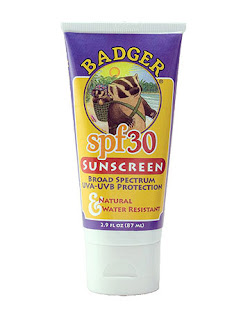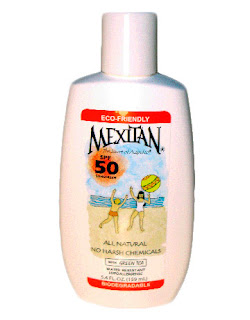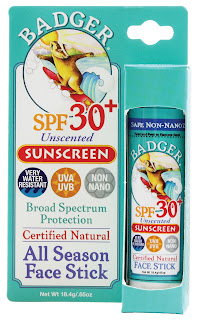No one knows sunscreen better than a lifeguard. I have spent the last four summers trying to not get completely fried in the sun. All of the eco-friendly sunscreens I highlight below have been thoroughly tested by myself.
Water resistant sunscreen (body)
One of the main problems I have with some eco-friendly water resistant sunscreens is that they can feel like you are slathering yourself in glue. Although the stickiest sunscreens typically stay on the best, it can get to the point where it feels almost impossible to rub in at all.
Nature’s Gate: Although this sunscreen has a few more chemicals than other sunscreens highlighted here, it works fairly well. It goes on easily and does not leave your skin overly white or greasy. This sunscreen works will for an hour or less if you are actively swimming, and longer if you are not spending too much time in the water.
EWG rating: 3

Badger: This is my go-to sunscreen for when I’m in the water at work. Teaching swim lessons mean I am in the water for up to 4 hours at a time. Little kids often grab onto my hands and arms, removing my sunscreen if it is isn’t tough enough. This sunscreen withstands it all! When I get out of the pool after a long day I have to really try to scrub it off. I have never gotten burned when using this, but I do try to reapply at least every 2 hours. As a warning, I would not use this on my face or back. It’s base is olive oil and I can see it potentially clogging pores if you have acne prone skin. Also beware that it will leave your skin looking blueish white.
EWG rating: 1

Mexitan: I should start by saying that this is my least favorite sunscreen. I actually refuse to use it and I have passed it on to my mom. This product could probably glue your class project together it’s so sticky. I struggle to rub it in and when I need to get my sunscreen on and get back to work in a few minutes, this just won’t work. That does not mean, however, that it does not work well. If you have the patience and you do not mind a slightly sticky sunscreen, this will work.
EWG: 3
Non-water resistant sunscreen
Some of these sunscreens may say water resistant on the bottle, but I have found that they work significantly better out of the water, and I will not wear them in the water.
BurnOut Kids: This is my favorite sunscreen when I have to spend a few hours on the lifeguard stand. Any time I will be out in the sun (and I will be staying out of the water) I bring this with me. The sunscreen seems really runny and I had my doubts about it the first time I used it, but I have not been burned when using it. It soaks in well and does not leave any discoloration or grease behind. This sunscreen is also comfortable when you are sweating in the warm sun.
EWG: 1
Nature’s Gate: This sunscreen rubs in well and does not leave a noticeable discoloration. It goes on a little oily, but it soaks in after a few minutes. However, it is the sunscreen with the most chemicals in it out of all of the ones featured here.
EWG: 4
Soleo Organics: If you will be spending all day in a bathing suit and have a lot of skin to cover, I would not bring this one with you mostly because it is so expensive. Although this sunscreen works well. It goes on fairly greasy and my skin remained slightly oily the rest of the day. I keep this sunscreen in my bag and use it when I find myself outside longer than expected (it’s a great size for a purse or short travels). I have also used this on my face a few times and surprisingly did not break out.
EWG: 1
Face and lips
Beyond Coastal: I cannot say this enough, I love this sunscreen. I hate wearing zinc that leaves my face white, but this one soaks in clear. I know it’s a lifeguard stereotype to have the white nose, but it’s just not for me. I wear this sunscreen on my entire face and ears. I wear a full body wetsuit at work when I have to be in the pool for hours at a time, and I put this all over the tops of my feet and the backs of my hands. I can swim around and have kids grab my hands without it coming off at all. After 2 summers of having my nose burned every single day I worked (I’m not exaggerating. By the end of the summer my nose would be raw and peeling), I was so thankful to find this. Once I started using this I never burned my nose again. It does not clog my pores at all. It is easy to reapply right out of the water. I just have to dry my face real quick and throw it back on. This sunscreen is great for in and out of the water.
EWG: 2

Badger Face Stick: I tragically lost my Beyond Coastal tin last summer, and I bought this out of complete desperation. It works just as well and it’s nice to have a stick sometimes, but it does go on a bit white. I still highly recommend it and I will continue to use both the Beyond Coastal and this one this summer.
EWG: 1
Lipcotz: This sunscreen lip balm keeps my lips well protected from the sun. Some warnings though: It will color your lips because of the minerals in the sunscreen. It’s not a bad color and it’s worth the protection. I also use another lip balm underneath this one for some moisture because this one is really best to just block the sun, not moisturize.
EWG: 3
Best aftersun
Korress Yoghurt Cooling Gel: If you accidentally get a sunburn (don’t worry, it happens to the best of us) this aftersun cooling lotion is the best. It helps take away some of the pain, moisturize your skin, and keep it from peeling later on (unless you really burned yourself, then you will probably still peel).
EWG: 0
You can find any of the sunscreens featured here online as well as some grocery stores like Whole Foods.
More options:
Wondering how your sunscreen is standing up? Check it against the EWG’s 2011 Hall of Shame sunscreens.
For more eco-friendly sunscreens that are safe to use, check out EWG’s list of some of the safest sunscreens.


































